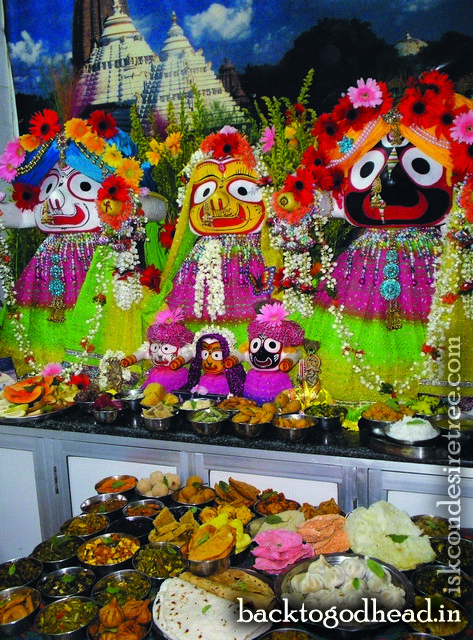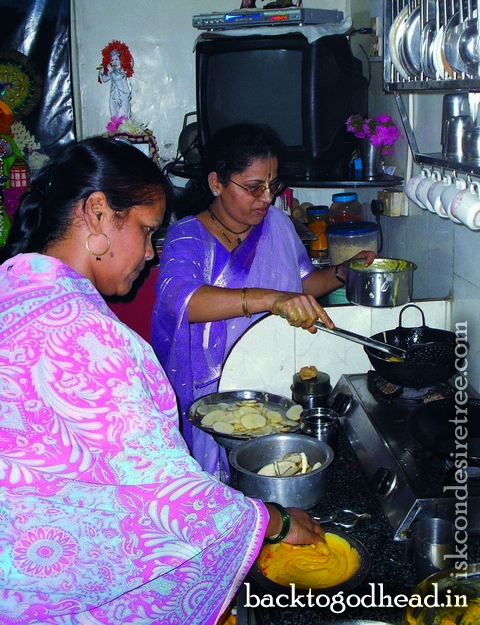In a tiny one-room house, a family serves the Lord with opulence seemingly beyond their means.

Saturday, 11:30 A.M. Vamsi Vihari Dasa, Vrajabasi Dasa, Ripin, and I arrive in Lalbagh, a section of Mumbai. We’ve come to interview a devotee named Satish, having heard about his and his family’s exemplary devotion. His tiny one-room house serves as both their home and a temple of Jagannatha, Baladeva, and Subhadra. Although he’s a low-salaried office clerk, he and others regularly cook a feast of fifty-six preparations for the deities, following a centuries-old tradition of service to Lord Jagannatha in Puri.
As we stand in front of a building, trying to locate Satish’s house, a tea-stall owner calls out to us.
“Hey, you Hare Krishnas, take a left and go behind this building.”
We looked at each other, bemused.
Then Ripin sums up our collective sentiments: “It seems Lord Jagannatha is quite famous here.” We walk past a few buildings with peeling paint and enter a similar one.
“Welcome!” Satish greets us and then takes us inside his one-room house.
In the ten-by-twelve-foot room, along one wall is a big platform on which stand two-foot-tall Jagannatha, Baladeva, and Subhadra Devi, each beautifully decorated with flower garlands and attractive dresses. Behind them is a panoramic view of Lord Jagannatha’s temple in Puri. On our right is a cooking range and atop it the kitchen vessels, neatly arranged on a metal rack. On the left is a long bench piled with containers of produce. On the floor two women fry vegetables on a single stove and two others cook on a shelf. A small girl, five or six years old, washes a carrot with her tiny hands and then passes it to her mother.
Despite the onerous job of cooking dozens of preparations on three stoves, the atmosphere is peaceful and unhurried. Devotees cook quietly while a sweet Hare Krishna kirtana plays on a CD player in the background. The room is clean, and there is no choking smoke, although there is only one window and we don’t notice any exhaust fan.
We take some photographs, and then Satish escorts us to the house of another devotee. We sit on straw mats and conduct our interview.
BTG: Please tell us how these deities came here?
Satish: In 2003 I went to Jagannatha Puri for the Rathayatra festival. I saw these deities in a shop outside the temple and spontaneously fell in love with them, especially because Jagannatha’s face was exactly like that of Jagannatha in the Puri temple. But I didn’t have enough money to buy them. I decided to return to Mumbai and save money to get them. Before leaving I prayed to Lord Jagannatha: “Please stay here. Next year I will definitely come and get You.” I promised Jagannatha, Baladeva, and Subhadra that if they were to come to my house, I would regularly offer them fifty-six bhoga items. [Bhoga, meaning “enjoyment,” is food to be enjoyed by the Lord.]
Back in Mumbai, for one year I tried to collect 9,000 rupees, the required sum, and my friend Vaikun†ha Dasa contributed whatever was short.
In January 2004 I again went to Puri, but I had forgotten the location of the shop. I checked various shops and saw many deities, but not the ones I wanted. Dejected, I began to walk aimlessly, when suddenly the same old shop appeared before my eyes. The same Jagannatha deities were there, standing at the same place I had seen them a year earlier. Only some dust had gathered upon them. Immediately I entered the shop, settled the transaction, and got the deities for 8,000 rupees.
My family welcomed the Lord with open hearts. My mother and father were very happy. When Jagannathaji arrived, local people welcomed Him with a shower of flowers.
Initially, we had a bed where you see the altar presently. We threw the bed out and made a platform for Their Lordships.
BTG: Why do you have such special attraction for these deities?
Satish: During the Rathayatra in Puri in 2003 an amazing thing happened to me. When I climbed onto the ratha [chariot] of Jagannathaji, as is the custom, it was so crowded that I couldn’t see Him. Suddenly the crowd parted, and somebody pushed me from behind. I landed right on top of Lord Jagannatha. My hands fell on His face and then parted sideways in an embrace. I was face to face with the Lord for a long time and noticed His features very closely. I touched His nose. It was so soft that I began wondering, “People say that He is made of wood, but how can wood be so soft?”
So, when I saw these deities I immediately felt attracted because they look exactly like the deities in the Puri temple.
BTG: When did you begin offering fifty-six bhoga items?
Satish: In 2004 we put on a local Rathayatra, and every day for one week we offered the deities fifty-six bhoga items. After the Rathayatra we decided to offer fifty-six bhoga items regularly. Initially we decided to offer them once a month. Later other devotees joined us in serving Their Lordships, and now we do so every week.
BTG: How much does the bhoga cost?
Satish: Around 1,000 rupees a week.
BTG: If you don’t mind our asking, what is your income?
Satish: Six thousand rupees a month.
BTG: How can you afford to spend so much on bhoga?
Satish: Everything is the mercy of Jagannathaji. My income has increased since He arrived, and my father also has some income.
BTG: How can you manage all this?
Satish: Everything is the mercy of Jagannathaji. For example there is a vendor from whom Vaikun†ha Dasa used to buy vegetables for the offering. When Vaikun†ha told him about our offering fifty-six bhoga items to Lord Jagannatha, he came and took darsana of Jagannathaji and began giving vegetables for free. And, mind you, he is not a rich vegetable vendor; he runs a small vegetable stall.
On Saturdays we do a special flower decoration. We design the clothes, and our neighbor, a tailor, stitches them for free. Jagannathaji engages everyone in His service.
Someone announces, “The bhoga is ready. Please come for the offering.”
We return to the room. In front of the Lord are large vessels, bowls, plates, and a tower of preparations, one atop another. After making the offering, we have to come out because there is no place to stand.
Satish’s mother and other ladies who were preparing the bhoga now join us. Satish’s mother is simple and shy, a traditional middle-aged Maharashtrian housewife. It takes a lot of cajoling from everyone for her to open up.
BTG: How do you manage this cooking in a kitchen of this size? Suvarna Gandhi (Satish’s mother): Lord Jagannatha gets everything done. We work in batches. On Friday we buy, wash, and cut the vegetables and prepare dry items like laddu and other sweets. Saturday morning at 6:30 we set up the pressure cooker and boil rice, dal, potatoes, and so on.
It is soon time to remove the offering, so we end the interview.
The Great Feast
Satish points to the only window of his house.

“Many people, while going to work, take darsana of the Lord through this window.” He points to a house directly opposite the door to his house. “A drunkard lived there. Now he has stopped drinking and daily offers arati to Lord Jagannatha from his house.”
We enter the room. There is place for only four or five people to sit and honor prasadam. We sit down with the first group. The most amazing thing is that after the hard labor of the entire day, Satish’s mother is not interested in honoring prasadam or resting; rather, she is there enthusiastically serving prasadam. She perfectly embodies the service attitude of a real Vaisnava. Even after we refuse, she lovingly serves us handfuls and spoonfuls of preparations.
And what a feast! There are more than ten types of curried and dry vegetables, fifteen types of sweets, numerous types of savories, as well as rice, raitas, chutneys, dahibhallas, bhel, dals, chapatis, parathas, papads, pickles, and what not. After serving prasadam, Satish’s mother prepares three bags full of dry prasadam for us to take to the devotees back at the Chowpatty temple.
We are totally moved by gratitude. Seeing how these devotees have engaged their mind, body, soul, and all their resources in the service of the Lord, we feel like offering obeisances at their feet. Seeing their selfless surrender and devotion to Lord Jagannatha, we feel like atheists.
What better example of the Supreme Lord’s mercy can be given than His incarnation as the deity? He comes personally in the deity form and makes Himself easily accessible to His devotees for rendering devotional service. And He doesn’t need opulent surroundings. Here He is, in a small corner of Mumbai, surrounded by faded buildings in a tiny one-room house, enacting amazing pastimes with seemingly ordinary people. Unless the Lord reciprocated the love of His devotees, how could these devotees continue to render selfless service in the most trying conditions?
Postsc ript With the help of savings and donations, Satish has bought the adjoining house and moved there, leaving the old house to serve solely as the temple, with an air conditioner. The devotees have increased their service of the deities and now do daily dressing and have a kirtana before Their Lordships rest at night.
Murari Gupta Dasa is part of the production team of the Hindi and the India English editions of BTG. He serves at ISKCON’s Chowpatty (Mumbai) temple and teaches Krishna consciousness to college students in Mumbai.
